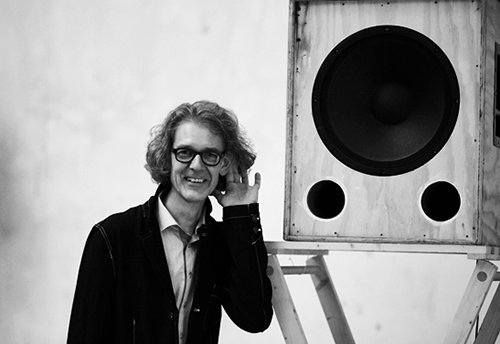Thomas Gorbach

photo (c) Markus Gradwohl
Thomas Gorbach (*1966, Vorarlberg/Austria) is the founder of Austrians first concert series that is dedicated to acousmatic music. With this project, The Acousmatic Project, he did intensive research within the last 10 years about building a multichannel loudspeakers orchestra, that finally is called The Vienna Acousmonium.
Every year two festivals are organised that present international artists working on computer-generated sounds and multichannel live diffusion. In the workshop Thomas Gorbach is training the development of his diffusion technique called Ephemeral Dynamic-Motion Sound Sculptures.
Traditional classic music studies in Switzerland specialized on Oboe, Composition and Conducting.
1996 move to Vienna – Studies in Analysis, Interpretation and Composition of Electroacoustic Music at the Electronic Music Department of the University of Music and Performing Arts Vienna.
Since 2006 lectures in Electroacoustic Music at the Vienna University of Technology
2007 – start to develop Austrian’s first Acousmonium, The Vienna Acousmonium
Since 2007 – over 40 concerts on his Acousmonium.
Inside-Out in Lines and Curves, 14:39 / 2017, stereo.
Within the composition Inside-Out two contrasting sound categories come together. These are granular corpuscles typical forming the gesture of scrolling and noisy metallic grinding balancing and rotating.
Listening to the sounds and there development may bring the interested one to the separating layer between Inner and Outer, a situation of the unknown, a balancing act between spaces in there deformation, extension, friction and fragmentation.
Four Variations with ribbed sounds, 9:32 / 2014.
The Variations are showing different transformations with ribbed sounds which originally come from a piano turned upside-down.Various ways of working with the piano strings were categorised before the composing process started. During the work with sound transformations a classification system appeared that gives the work its musical form:
1st Variation: soft-sonorous amplification of the ribs in orbiting form,
2nd Variation: sliding-down of ribbed sounds in combination with plane attacks,
3rd Variation: Mixture of soft-sonorous and harsh rib-sounds with time variations and plane attacks, forwards and backwards,
4th Variation: rubbing on strings, scaled, backwards, fast-rubbed attack of strings.
Flushrust, 9’38″ / 2019, stereo.
Flashrust was created in 2019 under the pressure of the summer heat when the hot dust often made the objects barely recognizable. Perseverance was the motto during seemingly endless repetitions of hot hours. Fascinated and deterred, I searched for a sound phenomenon of a vibrating continuum in transition to rotation and finally to white noise.
Impact From Mars, 11’37″ / 2020/21, octophonie.
On July 18, 2011 at noon, a meteorite from Mars strikes the desert near the city of Tissint in Morocco. This meteorite is here in the Natural History Museum and oscillates with the premiere of the piece inspired by it.
Impact from Mars is a compositional approach to an unknown object: its fundamental being, its chemical nature – amalgam – its trajectory, how it penetrates the Earth’s atmosphere … In falling, the stone carries a mystery, umpteen fantasies of its origin, but also of a possible near future through its destructive potential. In the process, a loop of thoughts arises and remains open … To then close again more concretely, to come closer to the unknown, the not yet thought. Analogous to listening: The space, the tempo, the timbre, the morphology … and in the next loop: the mass, the movement, the harmony … followed by: the direction, the sign and the weighting.
In Impact from Mars, the musical gestures traverse three different-sounding virtual spaces in varying degrees of compositional density. They collide, repel, and interpenetrate. Partly in densely-separated stratifications, then in semi-permeable transitions up to the complete permeability of the layers. The foreign is absorbed in listening.
